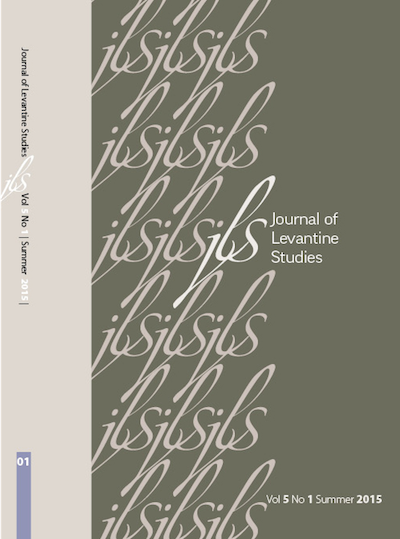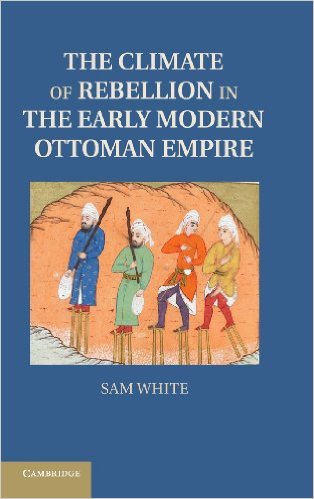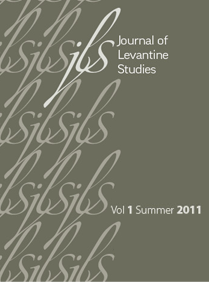-
Add to cartQuick view
The Foundational Antinativism of Mizrahi Literature
Theoretically or empirically, is it possible that a man could have written the first modern feminist story? Is it similarly possible that an Ashkenazi woman could have written the first protofeminist literary Mizrahi text? Answering in the affirmative, this essay unveils the antinativist Ottoman foundation for what contemporary scholars of Hebrew literature call “Mizrahi literature.” It does so by translating, for the first time into English, parts of a 3,700 word Hebrew story titled “Flora Saporto,” which was published in February 1914 in the periodical Haherut (1909–1917). The text was published under the pseudonym Bat Zvi, but it was written by suffragist and doyen of early modern Hebrew literature Nehama Puhachevsky (1869–1934). Bizarrely, however, during the century since its publication, this foundational story has been neither discussed nor analyzed by any scholar of Hebrew literature.
$5.00Free!Add to cartQuick view -
Add to cartQuick view
Skin Color Stratification in Israel Revisited
Free!Colorism refers to social stratification systems based on skin color. Colorism in Israel is significant because Israel is very ethnically stratified, a fact confirmed by the few scholarly works that have examined the subject. These works, however, do not employ the interests, methods, or key issues of colorism as a distinct academic field. The present study critically analyzes these works through the lenses of colorism scholarship in other national and cultural contexts. We found that existing studies focus on three themes: Jews of Ethiopian descent, with little attention to other groups; processes of attaching values to color categories, rather than the construction of the categories themselves; and the stigmatization by skin color of some marginalized groups.
Add to cartQuick view -
Add to cartQuick view
The Rear Side of the Front: Gaza and Its People in World War I
Free!During the First World War, the city of Gaza, a regional hub of forty thousand souls and a major market and exporter of grains, turned into a battlefield. While the military and political consequences of this arena are well researched, this article examines its civil and social aspects as well, in order to better understand the story of the First World War in Palestine. Using both British and Ottoman documentation alongside civil accounts and memoirs, the article discusses the reasons, methods, and effects of the city’s complete evacuation and the massive destruction of its physical environment. The civil perspective of the war reflected in the fate of Gaza poses a challenge to common chronological and spatial presumptions about the war itself, and it allows a rethinking of the Mandate period in the light of postwar circumstances.
Add to cartQuick view -
Add to cartQuick view
The City Square in the Performance of Taanit: From Rabbinic Space to Contemporary Jerusalem
Free!In winter 2012 the Israeli group Tnua Tsiburit (Public Movement) initiated Taanit (Civil Fast), a performance action that first took place at Davidka Square, in Jerusalem. Taanit was designed to explore the potential role of the body, and of bodily self-affliction, in social and political protest. An intertextual analysis of Taanit reveals it also as a site-specific interpretation of the city square that examines its political-theological significance by evoking traditional, religious layers of meaning given to that place. Following the reclaiming of the city square that characterized recent protests around the globe, Public Movement’s civil fast reactivates the religious underpinnings of modern urban space by juxtaposing it with rabbinic traditions, illuminating through performance the potential significance that the rabbinic space of public fasting has for modern urban politics.
Add to cartQuick view -
Add to cartQuick view
Islamic Law as Indigenous Law: The Shari‘a Courts in Israel from a Postcolonial Perspective
Free!The article argues that to better understand the shari‘a court system in Israel, these courts should be examined from a postcolonial perspective. The resemblance between Islamic law, as applied in Israeli shari‘a courts, and “customary” laws, which were applied by “indigenous” courts in diverse colonial settings, is discussed, and the similarities and differences are highlighted. Specifically, the article illustrates that the shari‘a courts in Israel—like other “indigenous” courts working in colonial settings—constitute, at one and the same time, sites of co-optation and of resistance. On the one hand, the shari‘a courts are state courts—governed and controlled by state institutions—and as such they are used by state authorities for the purpose of controlling and subjugating the Muslim minority in Israel; on the other hand, these courts also constitute a sociolegal space where Israeli Muslims may forge their identity and may negotiate their position toward the state. In other words, they constitute an arena of autonomous agency. This argument, which draws on the postcolonial literature, is illustrated in the article with empirical examples from the shari‘a courts in Beersheba and Jerusalem.
Add to cartQuick view -
Add to cartQuick view
Journal of Levantine Studies, Volume 5, No. 1: Summer 2015
Free!Add to cartQuick view -
Add to cartQuick view
Miriam Cooke. Tribal Modern: Branding New Nations in the Arab Gulf and Frederic M. Wehrey. Sectarian Politics in the Gulf
Miriam Cooke. Tribal Modern: Branding New Nations in the Arab Gulf and Frederic M. Wehrey. Sectarian Politics in the Gulf
$5.00Free!Add to cartQuick view -
Add to cartQuick view
Sam White. The Climate of Rebellion in the Early Modern Ottoman Empire. Cambridge: Cambridge University Press, 2013. 352 pp.
Sam White. The Climate of Rebellion in the Early Modern Ottoman Empire. Cambridge: Cambridge University Press, 2013. 352 pp.
$5.00Free!Add to cartQuick view -
Add to cartQuick view
What about Levantinization?
Free!This essay was written originally in English but it is only now that it is published in its original form. Kahanoff, born in Egypt to parents from Tunisia and Iraq, was a Western-educated polyglot who saw herself as a child of the Levant. Her article reflects the inherent ambivalence of the Armenians, Copts, Jews, Greeks, and Italians who in the pre-nationalist era regarded, as she did, the entire region as their home. Kahanoff asks why Levantinism threatens Israeli society and Sabra culture, which claims to be authentically indigenous, but in truth was created by relatively recent immigrants from Europe. She exposes the inherent hypocrisy of “authentic” Israeli culture and the Sabra’s fear of “a cultural mutation.”
The Levantines relinquished cultural authenticity because it did not serve them well and adopted modern Western characteristics and values. The price of this survival strategy was a loss of authenticity and of relations with the surrounding hegemonic society. The Sabra’s contempt for the newly arrived Levantines did not prevent them from absorbing the newcomers, which seemed preferable to isolating themselves within the small Jewish community in Israel. The question of cultural mutation as opposed to indigenous authenticity is presented in the essay in a broad historical context, both spatial (the vernacularization of Latin) and temporal (the host of empires that conquered the region and left their mark on its various peoples).
Add to cartQuick view -
Add to cartQuick view
Beyond the Sea of Formlessness: Jacqueline Kahanoff and the Levantine Generation
Free!Monterescu develops the idea of Levantinism as a cultural mutation and draws the discussion toward a conceptual framework of purity and ambivalence. Monterescu sees Kahanoff’s writings as testimony to the cosmopolitan ambivalence of people whose home is the region surrounding the entire Mediterranean; he also argues that their relationship with the hegemonic national society can be framed and understood using Georg Simmel’s concept of the “stranger.” The struggle of the societies in the region against colonialism led to a rejection of everything “non-authentic”—that is, everything foreign or European. The emerging “pure” territorial nationalism juxtaposed the “pure” indigenous inhabitants and the cosmopolitan strangers with connections across the sea: the Greeks, Italians, Turks and the Jews. Following Zygmunt Bauman, Monterescu sees the Levantines as multidimensional strangers who are a part of colonial modernism. Cosmopolitanism and anticolonial nationalism, he explains, are complementary rather than incompatible options. Monterescu supports the call for the creation of a new anthropology of the Levant in which conqueror and conquered are trapped together, and in which the Levantine stranger helps to historicize and deconstruct the very category of indigenousness.
Add to cartQuick view -
Add to cartQuick view
“The Mediterranean Option”: On the Politics of Regional Affiliation in Current Israeli Cultural Imagination
The growing appeal of Mediterraneanism or “the Mediterranean option” (ha-opt’sia ha-yam tikhonit) as it is often referred to in Israel, can be at least partially understood in relation to the Oslo peace negotiations and their promise of replacing Israel’s isolated position in the region with a model of economic, political, and cultural integration. Perhaps it was the apparent difficulties involved in reaching a peace agreement, rather than the promise of peace itself, that drove many Israelis, including key public figures and intellectuals, to embrace the “Mediterranean option.”
This paper closely examines the ideological stakes involved in the intellectual and cultural endeavors of making Israel “Mediterranean.” What, I ask, is the appeal of Mediterraneanism for Israelis at this particular time and juncture? How is it that an ethno-national culture, which for the most part has until recently rejected or ignored the Mediterranean (as both “sea” and “region”) as a site of cultural identification, negating it in favor of ethno-national territorial centrality, has suddenly so embraced the sea and its regional promise? And more precisely, what does this promise entail? How does the Israeli-Palestinian conflict prefigure within it? Finally, and most central to my investigation, is the relationship between yam tikhoniyut as a geo-cultural regional affiliation, and mizrachiyut as an ethnic Israeli-Jewish classification. How are we to understand these different articulations of Israeli/Jewish locality and collective identity, and how are we to further understand their distinct rendition of politics vis-à-vis the Zionist national project?
$5.00Free!Add to cartQuick view
- Home
- About JLS
- Issues
- Vol. 9 No. 1 | Summer 2019
- Vol 8 No 2 Winter 2018
- Vol. 8, No. 1: Summer 2018
- Vol. 7, No. 2: Winter 2017
- Vol. 7, 1: Summer 2017
- Vol. 6, Summer/Winter 2016
- Vol. 5, No. 2 Winter 2015
- Vol. 5, No. 1 Summer 2015
- Vol. 4, No. 2 Winter 2014
- Vol. 4, No. 1 Summer 2014
- Vol. 3, No. 2 Winter 2013
- Vol. 3, No. 1 Summer 2013
- Vol. 2, No. 2 Winter 2012
- Vol. 2, No. 1 Summer 2012
- Vol. 1, No. 2 Winter 2011
- Vol. 1, No. 1 Summer 2011
- Blog
- dock-uments
- Subscribe
- Submit
- Contact






